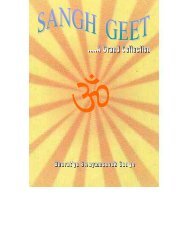Bauddhik Plan for Age Group 9-12 for - Hindu Swayamsevak Sangh ...
Bauddhik Plan for Age Group 9-12 for - Hindu Swayamsevak Sangh ...
Bauddhik Plan for Age Group 9-12 for - Hindu Swayamsevak Sangh ...
Create successful ePaper yourself
Turn your PDF publications into a flip-book with our unique Google optimized e-Paper software.
24<br />
May<br />
<strong>Hindu</strong> <strong>Swayamsevak</strong> <strong>Sangh</strong> (HSS)<br />
<strong>Hindu</strong> Dharma<br />
way we too should strive to remain pure and beautiful from within under all<br />
circumstances, not giving up on our basic nature of bliss.Lotus is also said to<br />
have emerged from the navel of Bhagwan Vishnu. Brahmaji originated from<br />
it to create the world. Hence, the lotus also symbolizes the link between the<br />
creator and the supreme cause. Lotus posture (padmaasana) is recommended<br />
when one sits <strong>for</strong> meditation. Lotus is also drawn as a rangoli <strong>for</strong> festive<br />
occasions. Lotus flowers are offered to the hindu deities during pujas.<br />
Shankh (Conch)<br />
Shankh represents dharma or righteousness that<br />
is one of the four goals of life. The sound of conch is<br />
thus also the victory call of good over evil. The story<br />
goes, the demon Shankhaasura defeated the devas,<br />
stole the Vedas and went to the bottom of the ocean.<br />
Bhagwan Vishnu in the <strong>for</strong>m of matsya (fish) killed<br />
Shankhaasura. Mahavishnu blew the conch-shaped<br />
bone of the asura’s ear and head. The sound of Om emanated, from which<br />
emerged the Vedas. All knowledge enshrined in the Vedas is an elaboration of<br />
Om. The conch there<strong>for</strong>e is known as shankh.Conch is blown traditionaly in<br />
poojas and sacred occasions. The sound of the conch produces auspicious<br />
sounds and drowns all negative noises that disturb the minds of worshippers.<br />
Lord Krishna blew the conch called the paanchajanya when he was charioteer<br />
to Arjuna in the Kurukshetra war.<br />
Kalash<br />
A kalash is a pot filled with water. Mango leaves are<br />
placed in the mouth of the pot and a coconut is placed over<br />
it. Sometimes red and white threads are tied around the<br />
Kalash. The water in the kalash symbolizes the giver of life to<br />
all and from which the entire creation emerged. The mango<br />
leaves and coconut represent creation and the threads around<br />
it signify the love that binds all in creation. The kalash is<br />
there<strong>for</strong>e considered auspicious and worshipped.





